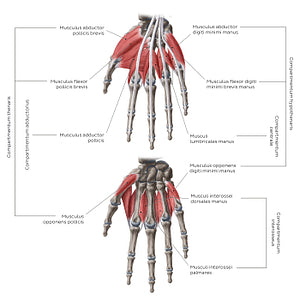Yousun Koh
Muscles of the hand: Groups (Latin)
Muscles of the hand: Groups (Latin)
The muscles of the compartimentum thenaris form the eminentia thenaris on the lateral aspect of the palm of the hand (manus). The m. opponens pollicis, m. abductor pollicis and m. flexor pollicis brevis extend from the retinaculum flexorium and tubercles of the os scaphoideum and os trapezium, to attach to the os metacarpi 1 or phalanx of the thumb (pollex). This group of muscles is largely responsible for creating opposition of the thumbThe m. adductor pollicis of the compartimentum adductorium is composed of two heads: an caput obliquum and a caput transversum. The caput oblique arises from the base of the ossa metacarpi 2-3, while the caput transversum originates from the anterior surface of the shaft of the os metacarpi 3. Both heads extend to insert onto the base of the 1st proximal phalanx. This muscle group is responsible for adduction of the thumb. The muscles of the compartimentum hypothenaris form the eminentia hypothenaris on the medial aspect of the palm of the hand. The m. abductor digiti minimi arises from the os pisiforme, while the m. flexor digiti minimi brevis and m. opponens digiti minimi both arise from the hamulus ossis hamati and the retinaculum flexorium on the lateral aspect of the hand. The mm. hypothenaris extend to insert onto either the os metacarpi 5 or proximal phalanx and function to facilitate opposition of the little finger. The compartimentum centralis is made up of the mm. lumbricales. The mm. lumbricales (4) are found between the ossa metacarpi, but unlike mm. interossei dorsales and palmares, they do not attach to the ossa metacarpi, and instead attach proximally to the tendons of m. flexor profundus digitorum.The compartimentum interossea is composed of the mm. interossei dorsales and palmares. The mm. interossei attach to the ossa metacarpi and extend to insert onto the proximal phalanges of associated fingers. The mm. interossei palmares function to adduct the 2nd, 4th and 5th digits towards the axial line, while the mm. interossei dorsales function to abduct the 2-4th digits away from the axial line.
Normaler Preis
$7.56 USD
Normaler Preis
Verkaufspreis
$7.56 USD
Grundpreis
pro
Verfügbarkeit für Abholungen konnte nicht geladen werden


#B14F4E
#A8615D
#6B1818
#473931
#E79997 und #CDB2AE

